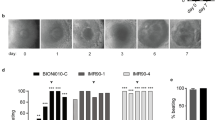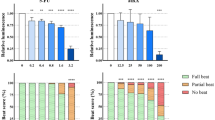Abstract
Musculoskeletal birth defects are frequent, yet their causes remain insufficiently investigated. Aside from genetic factors, exposure to environmental toxicants is suspected to contribute to the etiology of skeletal malformations. However, most chemicals in the environment are insufficiently characterized for their potential to cause harm to the differentiation of osteoblasts, the bone-forming cells and thereby the development of the skeleton.
This lack of information primarily stems from animal testing being prohibitively expensive and time-consuming, which has prompted the development of predictive in vitro alternative methods. With the advent of mouse embryonic stem cells, which represent cells with the potential to become any of the 200 cell types in the body, among them osteoblasts, the past 15 years have borne suitable opportunities to assess chemicals in vitro. However, with an increasing understanding of the differences between mouse and human embryonic development, a need for human-specific developmental toxicity testing has risen. This chapter provides a detailed protocol on how to differentiate human embryonic stem cells into the osteogenic lineage, how to assess differentiation inhibition and how to evaluate such findings in relation to the mitochondrial activity of human embryonic stem cells and human fibroblasts, while exposed to a potential toxicant. Together, these endpoints allow for a human-specific screening of developmental toxicity specifically related to the osteogenic lineage.
Access this chapter
Tax calculation will be finalised at checkout
Purchases are for personal use only
Similar content being viewed by others
References
Seiler AE, Spielmann H (2011) The validated embryonic stem cell test to predict embryotoxicity in vitro. Nat Protoc 6(7):961–978
Petrini J, Damus K, Johnston RB (1997) An overview of infant mortality and birth defects in the United States. Teratology 56:8–9
Krakow D, Rimoin DL (2010) The skeletal dysplasias. Genet Med 12(6):324–341
Holz JD, Sheu TJ, Drissi H et al (2007) Environmental agents affect skeletal growth and development. Birth Defects Res C Embryo Today 1:41–50
Pearl M, Boxt LM (1980) Radiographic findings in congenital lead poisoning. Radiology 136(1):83–84
Sauk JJ, Smith T, Silbergeld EK et al (1992) Lead inhibits secretion of osteonectin/SPARC without significantly altering collagen or Hsp47 production in osteoblast-like ROS 17/2.8 cells. Toxicol Appl Pharmacol 2:240–247
Klein RF, Wiren KM (1993) Regulation of osteoblastic gene expression by lead. Endocrinology 132(6):2531–2537
zur Nieden NI, Kempka G, Ahr HJ (2003) In vitro differentiation of embryonic stem cells into mineralized osteoblasts. Differentiation 71(1):18–27
zur Nieden NI, Kempka G, Ahr HJ (2004) Molecular multiple endpoint embryonic stem cell test--a possible approach to test for the teratogenic potential of compounds. Toxicol Appl Pharmacol 194(3):257–269
zur Nieden NI, Davis LA, Rancourt DE (2010) Comparing three novel endpoints for developmental osteotoxicity in the embryonic stem cell test. Toxicol Appl Pharmacol 247(2):91–97
zur Nieden NI, Davis LA, Rancourt DE (2010) Monolayer cultivation of osteoprogenitors shortens duration of the embryonic stem cell test while reliably predicting developmental osteotoxicity. Toxicology 277(1–3):66–73
zur Nieden NI, Baumgartner L (2010) Assessing developmental osteotoxicity of chlorides in the embryonic stem cell test. Reprod Toxicol 30(2):277–283
Madissoon E, Töhönen V, Vesterlund L et al (2014) Differences in gene expression between mouse and human for dynamically regulated genes in early embryo. PLoS One 9(8):e102949
Lin S, Lin Y, Nery JR et al (2014) Comparison of the transcriptional landscapes between human and mouse tissues. Proc Natl Acad Sci U S A 11(48):17224–17229
Thomson JA, Itskovitz-Eldor J, Shapiro SS et al (1998) Embryonic stem cell lines derived from human blastocysts. Science 282(5391):1145–1147
Sottile V, Thomson A, McWhir J (2003) In vitro osteogenic differentiation of human ES cells. Cloning Stem Cells 5(2):149–155
Bielby RC, Boccaccini AR, Polak JM et al (2004) In vitro differentiation and in vivo mineralization of osteogenic cells derived from human embryonic stem cells. Tissue Eng 9-10:1518–1525
Ding H, Keller KC, Martinez IK et al (2012) NO-β-catenin crosstalk modulates primitive streak formation prior to embryonic stem cell osteogenic differentiation. J Cell Sci 125(22):5564–5577
Sittner D, Huhse B, Steinfath M et al (2016) Osteogenic differentiation of human embryonic stem cell-derived mesenchymal progenitor cells as a model for assessing developmental bone toxicity in vitro. Appl In Vitr Toxicol 3:127–142
Rosa FW, Wilk AL, Kelsey FO (1986) Teratogen update: vitamin A congeners. Teratology 3:355–364
Deshmukh RS, Kovács KA, Dinnyés A (2012) Drug discovery models and toxicity testing using embryonic and induced pluripotent stem-cell-derived cardiac and neuronal cells. Stem Cells Int 2012:379569
Hackenberg U, Bartling H (1959) Messen und Rechnen im pharmakologischen Laboratorium mit einem speziellen Zahlensystem (WL24-System). Arch Exp Pathol Pharmakol 235:437–463
Davis LA, Dienelt A, zur Nieden NI (2011) Absorption-based assays for the analysis of osteogenic and chondrogenic yield. Methods Mol Biol 690:255–272
Acknowledgments
The data provided in this book chapter are the results of projects funded by the Tobacco Related Disease Research Program of California (TRDRP) (#19-0017H, #25IP-0018), and the Center for Alternatives to Animal Testing (#2013-11, #2014-14R2). This book chapter was written with the support from the National Institutes of Health, National Institute of Dental and Craniofacial Research (R01DE025330-01A1), and a fellowship from the TRDRP to NRLS (#24DT-0002). JVM is a California Institute for Regenerative Medicine funded Bridges fellow.
Author information
Authors and Affiliations
Corresponding author
Editor information
Editors and Affiliations
Rights and permissions
Copyright information
© 2018 Springer Science+Business Media, LLC, part of Springer Nature
About this protocol
Cite this protocol
Madrid, J.V., Sera, S.R., Sparks, N.R.L., zur Nieden, N.I. (2018). Human Pluripotent Stem Cells to Assess Developmental Toxicity in the Osteogenic Lineage. In: Félix, L. (eds) Teratogenicity Testing. Methods in Molecular Biology, vol 1797. Humana Press, New York, NY. https://doi.org/10.1007/978-1-4939-7883-0_5
Download citation
DOI: https://doi.org/10.1007/978-1-4939-7883-0_5
Published:
Publisher Name: Humana Press, New York, NY
Print ISBN: 978-1-4939-7882-3
Online ISBN: 978-1-4939-7883-0
eBook Packages: Springer Protocols




